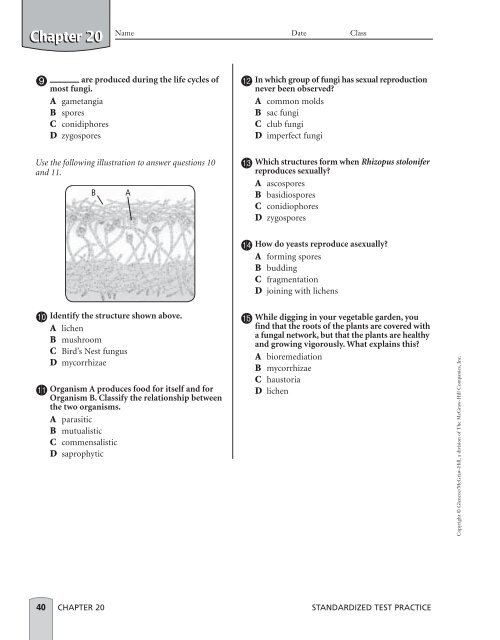biostp.2
biostp.2
biostp.2
You also want an ePaper? Increase the reach of your titles
YUMPU automatically turns print PDFs into web optimized ePapers that Google loves.
Chapter 20<br />
Name Date Class<br />
9<br />
are produced during the life cycles of<br />
most fungi.<br />
A gametangia<br />
B spores<br />
C conidiphores<br />
D zygospores<br />
Use the following illustration to answer questions 10<br />
and 11.<br />
<br />
<br />
bm<br />
In which group of fungi has sexual reproduction<br />
never been observed<br />
A common molds<br />
B sac fungi<br />
C club fungi<br />
D imperfect fungi<br />
bn<br />
Which structures form when Rhizopus stolonifer<br />
reproduces sexually<br />
A ascospores<br />
B basidiospores<br />
C conidiophores<br />
D zygospores<br />
bo<br />
How do yeasts reproduce asexually<br />
A forming spores<br />
B budding<br />
C fragmentation<br />
D joining with lichens<br />
bk<br />
Identify the structure shown above.<br />
A lichen<br />
B mushroom<br />
C Bird’s Nest fungus<br />
D mycorrhizae<br />
bl<br />
Organism A produces food for itself and for<br />
Organism B. Classify the relationship between<br />
the two organisms.<br />
A parasitic<br />
B mutualistic<br />
C commensalistic<br />
D saprophytic<br />
bp<br />
While digging in your vegetable garden, you<br />
find that the roots of the plants are covered with<br />
a fungal network, but that the plants are healthy<br />
and growing vigorously. What explains this<br />
A bioremediation<br />
B mycorrhizae<br />
C haustoria<br />
D lichen<br />
Copyright © Glencoe/McGraw-Hill, a division of The McGraw-Hill Companies, Inc.<br />
40 CHAPTER 20 STANDARDIZED TEST PRACTICE


